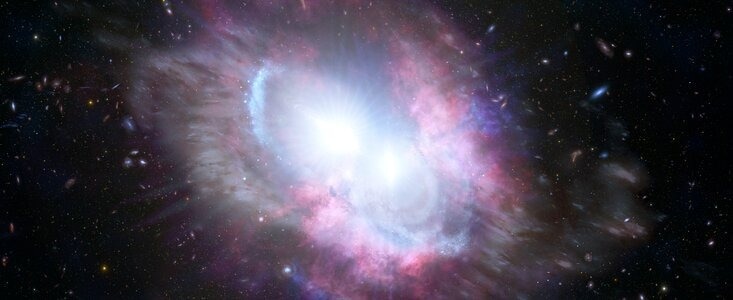A closely bound duo of energetic quasars—the hallmark of a pair of blending galaxies—have been discovered by astronomers with the help of an array of ground- and space-based telescopes, like Gemini North on Hawai‘I’. These quasars are observed when the Universe was just three billion years old.

Image Credit: NOIRLab
This breakthrough helps gain insight into the evolution of galaxies at the so-called “cosmic noon,” a period in the Universe’s history when galaxies experienced bursts of furious star formation. Also, this merger constitutes a system on the edge of turning out to be a giant elliptical galaxy.
The growth and evolution of galaxies happen by combining with other galaxies, blending their billions of stars, activating bursts of energetic star formation, and frequently fueling their central supermassive black holes to generate luminous quasars that surpass the complete galaxy.
Ultimately, some of these mergers go on to become huge elliptical galaxies that consist of black holes that are several billions of times the mass of the Sun.
Even though astronomers have noted a real menagerie of combining galaxies with over one quasar in their own cosmic neighborhood, further examples, seen when the Universe was just a quarter of its current age, are relatively rare and extremely difficult to determine.
By utilizing a bevy of ground- and space-based observatories—such as Gemini North, one half of the International Gemini Observatory, functioned by NSF’s NOIRLab—a group of astronomers has found a closely bound pair of actively feeding supermassive black holes—called quasars.
This breakthrough is the first verified detection of a pair of supermassive black holes in a similar galactic real estate at “cosmic noon”—a period of frenetic star formation at one time when the Universe was just three billion years old.
Earlier observations have identified similar systems in the early stages of merging when the two galaxies could still be noted as separate entities. However, such new outcomes display a pair of quasars blazing away in such a close neighborhood, a mere 10,000 light-years away, that their original host galaxies are probably well on their way to turning out to be a single huge elliptical galaxy.
Looking for pairs of supermassive black holes so close to each other at the time of this early epoch is like trying to determine the proverbial needle in a haystack. The difficulty is that the majority of the black-hole pairs are too close to differentiate individually.
For such a system to be detected definitively, it is necessary for the two supermassive black holes to be actively accreting and shining as quasars concurrently, conditions that are very unusual. On a statistical basis, for every 100 supermassive black holes, only one must be accreting actively at a given time.
But astronomers know that the distant Universe must be brimming with pairs of supermassive black holes fixed within merging galaxies. The initial hints of such a system were discovered in data from the NASA/ESA Hubble Space Telescope, which disclosed two closely aligned pinpoints of light in the faraway Universe.
For this system to be verified, the research group searched via ESA’s Gaia observatory’s huge database and discovered that this system had an evident “jiggle,” which can be the outcome of sporadic changes in the feeding activity of the black hole.
Furthermore, the team made use of the Gemini Multi-Object Spectrograph (GMOS) and GNIRS on Gemini North, offered the team separate measurements of the distance to the quasars and verified that the two objects were both quasars instead of a chance alignment of a single quasar with a foreground star.
Additional studies with the W.M. Keck Observatory, NSF’s Karl G. Jansky Very Large Array, and NASA’s Chandra X-ray Observatory also assisted in verifying such observations.
The confirmation process wasn’t easy and we needed an array of telescopes covering the spectrum from X-rays to the radio to finally confirm that this system is indeed a pair of quasars, instead of, say, two images of a gravitationally lensed quasar.
Yue Shen, Study Co-Author and Astronomer, University of Illinois
“We don’t see a lot of double quasars at this early time. And that's why this discovery is so exciting. Knowing about the progenitor population of black holes will eventually tell us about the emergence of supermassive black holes in the early Universe, and how frequent those mergers could be,” stated graduate student Yu-Ching Chen of the University of Illinois at Urbana-Champaign, lead author of this study, which is published in the journal Nature.
Journal Reference:
Chen, Y-C., et al. (2023) A close quasar pair in a disk–disk galaxy merger at z = 2.17. Nature. https://doi.org/10.1038/s41586-023-05766-6.